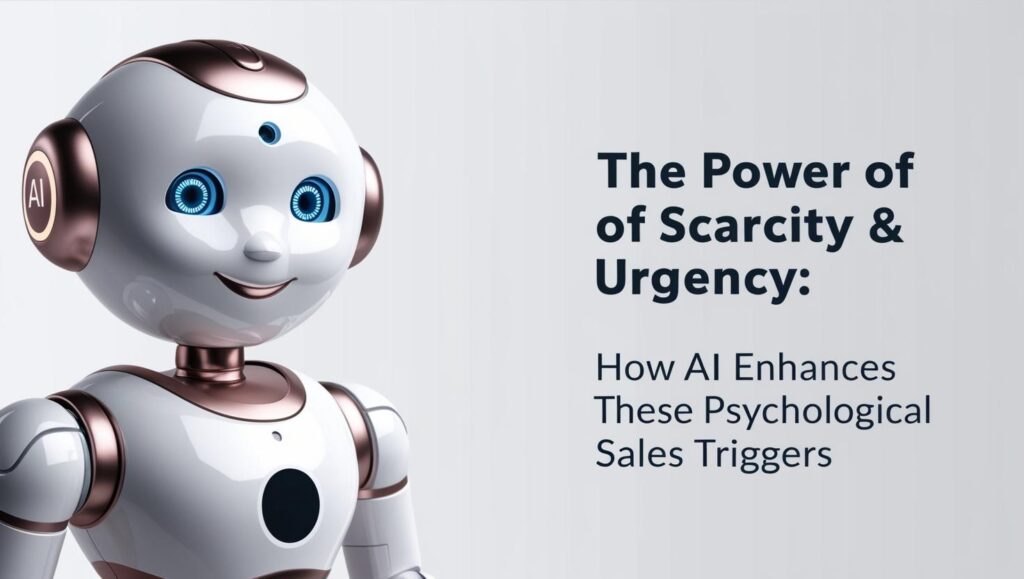 Steve Sipress
Head Rhino & Chief Strategist
Steve Sipress
Head Rhino & Chief Strategist
The Power of Scarcity & Urgency How AI Enhances These Psychological Sales Triggers

Why “Buy Now” Works Better When AI Says So
Have you ever found yourself rushing to buy something because “only 2 items left!” or “offer ends in 24 hours”?
You’re not alone. That only proves that you’re human.
Scarcity and urgency are powerful psychological triggers that make us act fast — and now AI is making these tactics even more effective for smart businesses.
Here’s how mid-sized companies have been using AI to supercharge these two age-old, time-tested sales techniques without coming across as pushy or fake…
The Science Behind Scarcity & Urgency: Why Our Brains Can’t Resist
Before diving into the AI magic, let’s understand why these triggers work so well…
- When something seems scarce, studies show our brains value it 70% to 80% more highly
- The fear of missing out (FOMO) activates the same brain regions as physical pain
- Decision-making time drops by 60% or more when genuine urgency is introduced
As one sales director told me, “We knew scarcity worked, but we didn’t realize how much money we were leaving on the table by using it wrong. AI showed us exactly when and how to apply pressure — and our conversion rates jumped 41.6% last quarter!”
AI-Powered Inventory Predictions: Real Scarcity That Customers Trust
Nothing kills trust faster than fake scarcity claims. AI helps create honest urgency by…
- Predicting exactly when products will sell out based on real-time demand
- Displaying personalized “low stock” warnings only when truly relevant
- Creating authentic limited-time offers based on supply chain realities
A retail operations manager shared, “Our AI system predicted we’d run out of our bestselling product 6.35 days before our next shipment. We turned this potential problem into our most successful flash sale ever!”
Personalized Urgency Messages: The Right Pressure at the Right Time
Not all customers respond to the same urgency triggers. AI tailors the approach by…
- Analyzing which scarcity messages each customer responds to (price increases, stock levels, or time limits)
- Determining the optimal timing for urgency messages (some people need days, others respond in minutes)
- Personalizing countdown timers and inventory alerts for maximum impact
One marketing director laughed when she said, “We discovered that our B2B customers responded 159.3% better to ‘limited consultation slots’ than ‘limited product availability.’ We would never have guessed that without AI analysis!”
Dynamic Pricing Based on Scarcity Signals: Finding the Sweet Spot
AI doesn’t just tell you when to use scarcity It helps you price accordingly…
- Automatically adjusting prices based on inventory levels and demand
- Creating tiered “early bird” pricing that feels fair to customers
- Identifying the perfect discount that creates action without sacrificing profit
Think of AI as your own brilliant pricing strategist who works 24/7/365.
One e-commerce manager told me, “Our AI tool suggested raising prices by 12.7% on items with low stock instead of discounting them. It seemed counterintuitive, but sales actually increased!”
Keeping It Ethical: How AI Helps Avoid Dark Patterns
The line between effective urgency and manipulative tactics can be thin. AI helps keep you on the right side by…
- Distinguishing between creating genuine urgency and false scarcity claims
- Testing customer satisfaction after urgency-based purchases (happy customers mean ethical tactics)
- Identifying when urgency messages might damage long-term brand trust
As one customer experience leader put it, “We want customers who are excited about their purchase, not regretful. Our AI helps us create urgency without crossing into manipulation. I can’t tell you how priceless that is.”
What This Means for Your Business
For mid-sized companies, AI-enhanced scarcity and urgency tactics create the perfect balance: the conversion power of psychological triggers along with the precision of data science.
The businesses seeing the biggest gains aren’t replacing their marketing intuition with AI. They’re using AI to validate their hunches, find blind spots, and apply these powerful psychological triggers more effectively.
Remember: The goal isn’t to pressure customers into decisions they’ll regret.
It’s to help them overcome procrastination for products they genuinely want and need.

Recent Comments